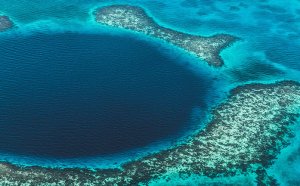
CDC Travel Belize
Sunburn is the most common problem for fair-skinned travelers to tropical regions. Belize is closer to the equator than the U.S., Canada or Europe, and the sun is far more intense. Use sunscreen and plenty of it. Snorkel in a tee-shirt.
You can drink the water in most areas of Belize (each section of this guide has recommendations on water at the destination, but ask locally if you're not sure). Even street food is usually safe, but that doesn't mean you won't get Belize Belly. The local microbes may be just different enough from those back home to give your system fits. Another culprit is the combination of hot sun and too many Belikins. If you have a nervous tummy, a daily dose of Pepto usually will help prevent any problems. If you get an upset, avoid medicines which "plug" you up; instead, rest, eat bland foods lightly (papaya is helpful to some) and drink plenty of fluids. If problems continue, see a doctor.
Some people aren't much bothered by sandflies (aka sandfleas or no-see-ums). Some are. Sand flies are common in mangrove swamp areas and in the sand in some areas, notably the Hopkins area, Caye Caulker and Placencia. Quite a few travelers go home with ugly bites which don't seem to heal. If that happens to you, see your doctor who can prescribe an ointment which usually will quickly take care of the bites. However, a more serious problem which can be caused by the bites of sandlflies is leishmaniasis, a disease which may cause the skin to develop sores, leaving scars. If infections from sandfly bites don't seem to heal, seek out a tropical medicine specialist. Another nasty insect in Belize that sometimes gives travelers a little present to take home is the botfly. With the help of a mosquito, the botfly egg is deposited under your skin. It grows, still under your skin, into a little worm-like larva. Not pleasant, but it's easily treated by cutting off the oxygen supply to the larva by smearing your skin with vasoline or other grease; after the botfly larva dies, you can remove it. Click here for a little more on sandflies...
Belize has about two dozen varieties of poisonous snakes (only about nine are actually potentially lethal), along with stinging scorpions (not deadly but painful), tarantulas (they make great pets) and vampire bats (don't sleep outside naked). Honey bees in Belize are virtually all now Africanized, and these killer bees are aggressive, sometimes killing farm animals and humans who are unable to escape. Under the sea are a variety of meanies, from hammer head sharks to moray eels and stingrays.
The average visitor, however, has far more to fear from traffic accidents than any natural-born killer. Traffic accidents have become the leading cause of death in the Belize, accounting for about one-fourth of all deaths, followed by homicide and AIDS. Belize drivers are often poorly trained, and driving after drinking unfortunately is a much more common practice on a per capita driver basis in Belize than in Europe, Canada or the U.S.
Ask a Belize resident about malaria, and you'll often get the response, "I've lived here for 17 years, I don't take anything and I never got malaria." With mosquito eradication programs in place in Belize, malaria is much less of a problem now than it was even as late as the 1980s. But there are still several thousand cases of malaria reported in Belize every year, mainly in the south and in remote areas of the north and west. Cases of malaria are rare in populated areas such as Belize City and on the cayes. Most travelers to these areas don't take any special precautions. Note, however, that the CDC states there is malaria risk everywhere in Belize except in Belize District. If you're going to the far south or to remote jungle areas, certainly it's better to be safe than sorry. Cover up at times, such as the early evening, when the Anopheles mosquito is active, use an insect repellent with DEET, and consider taking chloroquine (trade name Aralen), generally considered a safe and effective prophylaxsis for areas where strains are not chloroquine-resistant. Check with the CDC for the latest information, or see your doctor.
Dengue fever is not common in Belize, but it does occur in the region _ it has been widespread in the Yucatán _ and sometimes occurs in Belize, especially during and just after the rainy season. Symptoms of the types of dengue found in Belize are similar to that of the flu. At present, there is no preventive medicine. Avoid getting bitten by the Aedes aegypti mosquito, which, unlike the mosquito which transmits malaria, is often found indoors in urban areas and is active during the day, with prime feeding times being the morning and late afternoon. If you get it, rest and take acetaminophen (Tylenol and other brands), not aspirin.
Chagas' disease, or the "kissing bug" disease, transmitted by a bug which in Belize is occasionally present in the thatch roofs of poorly maintained structures and which drops down to bite and infect its victim. Chagas' disease can be effectively treated with drugs, but if left untreated it can permanently damage the heart. There is very, very slight risk of filariasis and onchocerciasis (look'em up) in Belize.
The risk of cholera and typhoid, serious diseases elsewhere in the region, is considered low in Belize. Rabies is present, but rarely affects travelers.
Do You Need Any Shots?
The only required inoculation to visit Belize is for yellow fever, and that is only if you're coming from an infected area such as Sub-Saharan Africa or parts of South America including Venezuela, Colombia and Brazil. See your doc or listen to the CDC's advice, but experienced travelers to Belize often recommend preventative sticks for tetanus, diphtheria and measles. Shots for Hepatitis A and B also are a good idea.
As noted above malaria is a slight risk in Belize, especially if you are going to remote areas in the far south. Chloroquine may be prescribed by your physician. This once-weekly tab, which must be taken one week before arrival, weekly during the trip, and then for four weeks following, is considered a safe prophylaxsis for the type of malaria present in parts of Belize; side effects are not significant for most people. Young children may find the pill difficult to take.
RELATED VIDEO


Share this Post
Related posts
Travel Belizes
1. Actun Tunichil Mukna (ATM Cave) Actun Tunichil Muknal, which means “Cave of the Stone Sepulchre” and is often referred…
Read MoreBelize Travel Guides
I am a strong advocate for hiring a local guide whenever travelling. Guides have a wealth of knowledge of the destination…
Read More










